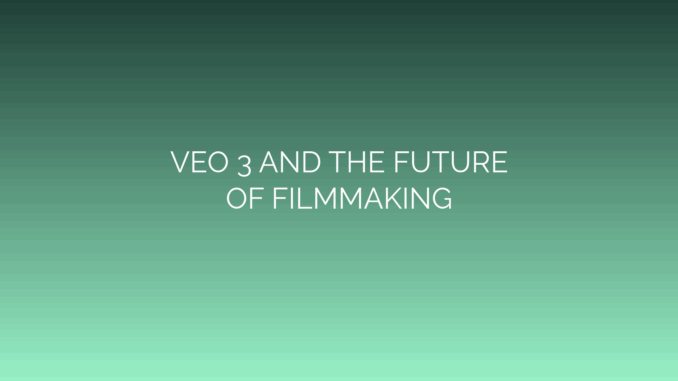
Veo 3 and the Future of Filmmaking
The landscape of motion picture creation is undergoing a seismic shift. Emerging technologies, particularly AIdriven tools, are dismantling traditional barriers to entry and redefining artistic possibilities. At the forefront of this evolution stands Veo 3, a revolutionary camera system poised to transform how stories are captured, produced, and experienced. Its advanced capabilities signal a new chapter in cinematic innovation—one where accessibility, efficiency, and creative flexibility converge.
What is Veo 3?
Veo 3 represents the next generation of intelligent imaging technology, merging cuttingedge hardware with generative artificial intelligence. Though specifications continue to evolve, core features highlight its disruptive potential:
- High-Resolution Imaging: Capable of recording in stunning 8K-16K resolution with dynamic color science.
- AI-Assisted Framing: Real-time algorithms analyze scenes to suggest compositions, lighting adjustments, and movement tracking.
- Generative Enhancement: Onboard AI can extend backgrounds, simulate complex lighting environments, or remove unwanted elements during filming.
- Lightweight & Adaptive Design: Modular architecture allows cinematographers to configure it for drones, gimbals, or handheld rigs with ease.
- Cloud Integration: Instant processing and collaborative workflows via cloud-based AI platforms.
Unlike conventional cameras, Veo 3 transcends being a passive recording device—it acts as an active creative collaborator.
Transforming the Creative Process
1. Democratizing HighEnd Production Historically, achieving “cinematic” visuals required costly equipment and specialized crews. Veo 3 dramatically lowers these barriers. Its AI algorithms replicate sophisticated techniques—such as depthoffield manipulation or virtual set extension—previously possible only in postproduction or large studios. Independent filmmakers and documentarians can now realize complex visions without multimilliondollar budgets.
2. Accelerating Workflows Time is a critical resource in filmmaking. Veo 3 streamlines production through predictive automation:
- Previsualization: Directors use generative AI to create rough scene mockups on location, aligning crew vision instantly.
- Smart Editing: Footage is auto-tagged for emotional tone, composition, or action beats, slashing editing timelines.
- Automated Color Grading: Scene-adaptive AI applies nuanced color profiles and maintains consistency across shots.
These efficiencies redefine “runandgun” filmmaking, empowering rapid iteration without sacrificing quality.
3. Redefining OnSet Collaboration Veo 3’s connective intelligence allows realtime data sharing. Directors, cinematographers, VFX supervisors, and editors can interact with the same generated scene simulations simultaneously—even remotely. This unified environment minimizes miscommunication and accelerates decisionmaking, turning disjointed pipelines into fluid, collaborative ecosystems.
Implications for Professional Filmmaking
Virtual Production Integration Veo 3 seamlessly integrates with LED volume stages and virtual production tools. Its AI can dynamically match physical lighting to digital backdrops or generate photorealistic environments incamera. This synergy reduces reliance on costly location shoots while granting unprecedented control over visual storytelling.
Ethical Nuances The rise of AIdriven cameras sparks critical debates:
- Authenticity: How will AI enhancements impact documentary ethics or audience trust?
- Creative Ownership: Who “owns” art when AI contributes to lighting, composition, or scene generation?
- Workforce Impact: While tools like Veo 3 empower small teams, guilds are scrutinizing AI’s effect on traditional roles (e.g., VFX artists, colorists).
Industries must establish ethical frameworks alongside technological adoption.
Veo 3 in Action: Use Cases
- Indie Filmmaking: Solo creators direct entire films using Veo 3’s AI assistants for storyboarding, shooting, and editing.
- Commercial Production: Brands rapidly prototype ads, generating product visuals against AI-backdrops for A/B testing.
- Documentaries: Field researchers stabilize shots in chaotic environments and enhance low-light footage without grain.
- Education: Film schools adopt Veo 3 to teach complex cinematography techniques through interactive AI guidance.
Challenges and Limitations
Veo 3 isn’t a panacea. Constraints remain:
- Algorithmic bias risk in AI-generated content.
- High computational power demands for real-time rendering.
- Potential over-reliance on automation, stifling serendipitous creativity.
Human intuition, emotional intelligence, and artistic intent remain irreplaceable. Veo 3 is a tool—not an auteur.
The Road Ahead: Filmmaking in 2030
Veo 3’s trajectory suggests a near future where:
- Hybrid Creatives Thrive: Directors/DPs leverage AI as a co-pilot, focusing on narrative and performance while technology handles technical execution.
- Audiences Immerse Deeper: Hyper-personalized films adapt in real-time to viewer reactions using Veo 3’s data-rich footage.
- Sustainable Practices Grow: Reduced location scouting and physical sets lower the industry’s carbon footprint.
Generative video platforms using Veo 3like systems will further blur boundaries between “captured” and “created” imagery.
Conclusion
Veo 3 symbolizes more than incremental innovation—it heralds a creative paradigm shift. By fusing optical excellence with artificial intelligence, it empowers storytellers to visualize the unimaginable and produce with unprecedented agility. While ethical and artistic challenges require vigilance, the democratization of cinematic tools promises richer, more diverse narratives. As Veo 3 and its successors evolve, one truth endures: technology amplifies human creativity but cannot replace it. The future of filmmaking belongs to those who wield these tools with vision, responsibility, and audacity.

Leave a Reply